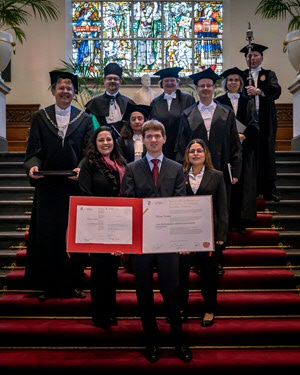First CogniGron PhD thesis! Wytse Talsma succesfully defended.
On Friday November 5 2020 Wytse Talsma succesfully defended his dissertation and received his PhD. The first PhD thesis with CogniGron research!! Congratulations to Dr. Talsma and supervisor Prof. Maria Antonietta Loi!! CogniGron is proud to have this as our first PhD thesis.

The thesis, "Low-dimensional solution-processable electronics: From field-effect transistor to artificial synapse", discussed and provides a potential solution to the need for novel computing hardware. Modern-day computing has irreversibly impacted our way of living. Nowadays, we are surrounded by computers that become smarter and more connected every day. The demand for more powerful hardware increases, while physical limitations already come into play. Pushing the boundaries of hardware development requires a new strategy, especially for (visual) pattern recognition. For this, a novel material candidate is semiconductive single-walled carbon nanotubes (s-SWCNTs). They promise inexpensive and scalable production methods for electronics. This thesis focuses on experimental research for the preparation and utilisation of these s-SWCNTs. We optimised s-SWCNT ink preparation by substituting the applicator-solvent in a colloidal dispersion of polymer-wrapped s-SWCNT. This resulted in improved shelf-life, field-effect transistor (FET) performances and device reproducibility. Also, we successfully demonstrated three newly designed low-bandgap polymers that wrap and select s-SWCNT. This resulted in FETs with improved energy-band alignment, potentially lowering energy consumption. More insight is provided into the relationship between the polymer structure and the dispersion capability for s-SWCNT, subsequently, the final inks' physical properties. Finally, we demonstrated that sufficient plasticity arises to obtain a functional artificial synapse using simple pulse-shapes by utilising the hysteresis commonly found in bottom-gate structure SWCNT FETs. As synapses are the functional connection between neurons and are believed to be the units enabling learning and computing, our finding enables usage in more energy-efficient computing architecture. We conclude that our improved inks can be easily industrially applied. The artificial synapse can potentially be used by neuromorphic computing for everyday pattern recognition tasks, enabling more powerful hardware.
The dissertation can be found on the University Groningen webpage.

| Last modified: | 11 November 2021 09.20 a.m. |
More news
-
21 May 2024
Results of 2024 University elections
The votes have been counted and the results of the University elections are in!
-
13 May 2024
Trapping molecules
In his laboratory, physicist Steven Hoekstra is building an experimental set-up made of two parts: one that produces barium fluoride molecules, and a second part that traps the molecules and brings them to an almost complete standstill so they can...
